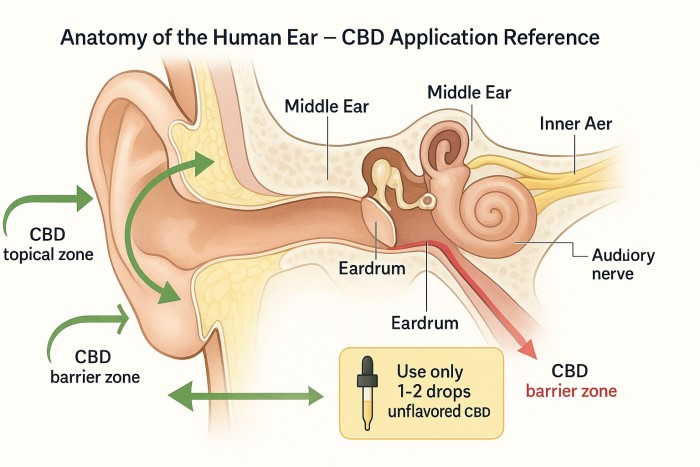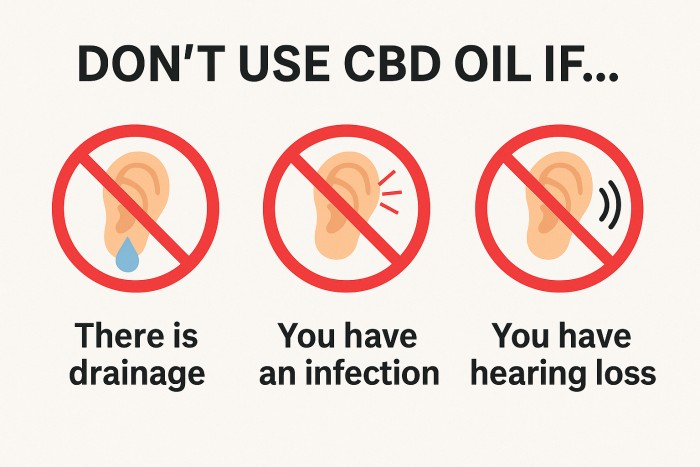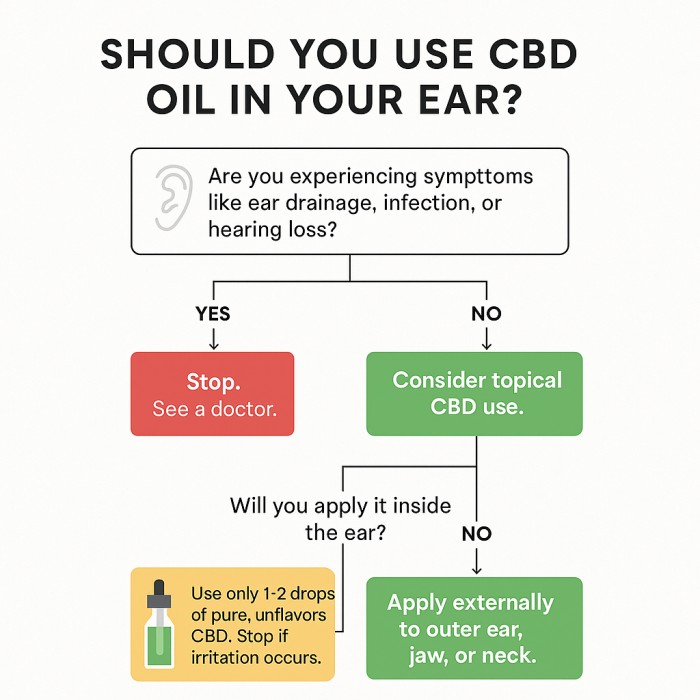CBD oil has captured global attention for its potential to ease discomfort, inflammation, and a range of health conditions.
But when it comes to earaches, infections, or tinnitus, some wonder: “Can you put CBD oil in your ear?”
Let’s break down the science, safety concerns, and practical advice you need to know before reaching for that dropper.
Quick Reference: CBD Oil In Ear Cheat Sheet
- 🔓 Direct ear application? Not recommended
- 🔼 Safer use? Topically around ear or oral ingestion
- 🖉 Conditions helped? Inflammation, mild aches (anecdotally)
- ⚠️ Major risks? Infection, irritation, blockage
- 🔧 Talk to a doctor before use!
Can You Put CBD Oil In Your Ear?
Short Answer: Technically, yes — but it comes with significant precautions.
Direct application of CBD oil into the ear canal is not widely recommended by healthcare professionals, mainly due to the delicate structure of the ear and the potential for complications.
CBD oil is designed for oral, topical, or sublingual use.
The ear is a highly sensitive area, and introducing oils directly can risk irritation, blockage, or worsen an existing condition.

Can You Safely Use CBD Oil Inside Your Ear?
While most medical sources advise against putting any oil directly into the ear canal, some users, including myself, have tried it cautiously for temporary relief from ear discomfort.
✅ My Experience
When I experienced ear pain, I used a small amount of Joy Organics Unflavored CBD Oil — a high-quality, lab-tested product with no flavoring, sweeteners, or additives.
The goal was to reduce inflammation and soothe discomfort naturally.
I avoided any CBD product with peppermint, lemon, or artificial flavors, which could be irritating or harmful inside the ear.
🔍 Note: This was a personal choice and not a medical recommendation.
⚠️ If You Decide To Try This…
Here’s a list of best practices to follow if you choose to use CBD oil in your ear — though you should always consult a healthcare provider first.

Safe Use Checklist
| Step | Safety Tip |
|---|---|
| 1. Choose the Right Product | Use a pure, unflavored CBD oil with a Certificate of Analysis (COA) to ensure no additives, alcohol, or essential oils are present. |
| 2. Check for Ear Conditions | Do not use if you suspect an infection, experience drainage, or have a ruptured eardrum. These require medical care, not oils. |
| 3. Warm Slightly (Optional) | Gently warm the bottle by holding it in your hands. Cold drops can cause dizziness. |
| 4. Lie on Your Side | Place your head sideways with the affected ear facing up. This allows the oil to settle without flowing too deeply. |
| 5. Use 1–2 Drops Only | Use a sterile dropper and limit the amount. Do not fill the canal — just coat the entry area. |
| 6. Stay Still for a Few Minutes | Remain in the same position to let the oil settle. Then sit up and wipe away any excess. |
| 7. Monitor Your Reaction | If you feel increased pain, pressure, or irritation, stop use and contact a healthcare provider. |
Is It Truly Safe?
There is no formal clinical research confirming that CBD oil is safe or effective when placed inside the ear canal.
That said, some individuals report relief from discomfort when used carefully and sparingly.
If you’re unsure, consider applying the CBD around the ear and jawline instead — this can still provide localized relief through transdermal absorption without risking inner ear complications.
⚠️ Important: If you have ear pain lasting longer than 1–2 days, or symptoms like fever, swelling, or discharge — skip the oils and see a doctor immediately.

How CBD Works: The Science Explained
CBD (cannabidiol) interacts with the body’s endocannabinoid system (ECS), which helps regulate pain, inflammation, and immune responses.
Research suggests that CBD can:
- Reduce inflammation
- Modulate pain signaling
- Support immune responses
However, the skin inside the ear is thin, and absorption rates differ greatly compared to other areas like joints or muscles.
Thus, the effectiveness of topical CBD in the ear is not scientifically confirmed.
Potential Benefits: What Users Hope For
While clinical research is sparse, anecdotal users and early studies suggest CBD may help with:
Potential Benefits: What Users Hope For
| Condition | Possible CBD Benefit |
|---|---|
| Ear Pain | Anti-inflammatory, mild analgesic effects |
| Tinnitus | Calming effect on stress/anxiety associated with tinnitus (no cure) |
| Minor Ear Infections | Potential antibacterial and anti-inflammatory support (needs more evidence) |
| Eustachian Tube Dysfunction | May help reduce surrounding inflammation, easing ear pressure (anecdotal) |
| Jaw-Related Ear Pain (TMJ Disorders) | Muscle relaxation, reduced inflammation in jaw muscles near the ear |
| Swimmer’s Ear (Mild External Irritation) | Possible soothing of outer ear skin (only externally, not internally) |
| Post-Infection Ear Sensitivity | May reduce lingering inflammatory discomfort after healing (supportive use only) |
| Ear Pressure from Sinus Congestion | Systemic anti-inflammatory support could mildly aid symptoms (indirect effect) |
Important: CBD cannot cure ear infections, tinnitus, Eustachian tube dysfunction, or hearing loss. It may ease secondary symptoms like pain, pressure, or irritation — but it is not a replacement for professional medical treatment.
Risks Of Putting CBD Oil In Your Ear
Medical professionals strongly caution against placing oils — even natural ones like CBD — directly into the ear canal.
Here’s why:
- Infection Risk: Oils can trap bacteria or fungi, leading to worsened infections.
- Ear Drum Damage: If there’s a perforation, any liquid introduced can damage the middle ear.
- Irritation: Some people may react negatively to carrier oils or additives.
- Blockages: Oil residue may contribute to earwax buildup, causing hearing issues.

Safer Ways To Use CBD For Ear Issues
If you’re seeking relief from ear-related discomfort, safer options include:
- Topical Application Around the Ear: Applying CBD oil on the skin around the outer ear may provide localized anti-inflammatory support.
- Oral CBD Oil: Consuming CBD orally allows systemic absorption, which might help ease general inflammation or discomfort.
- CBD Balms: Some topical CBD balms are designed for areas around the body and may offer gentle relief without risking inner ear complications.
Real World Experiences: What Users Report
Some users report mild relief from:
- Outer ear aches (not inner ear infections)
- Jaw tension causing ear pain (e.g., TMJ disorders)
- Stress-related tinnitus symptoms
However, results vary greatly, and experiences are not a substitute for medical advice.
Expert Opinions: What Healthcare Providers Say
Most healthcare professionals advise:
- Do NOT put CBD oil directly into your ear without medical supervision.
- DO seek immediate help if you experience severe ear pain, drainage, or hearing loss.
- Consider CBD as an adjunct to medical care, not a replacement.
“The ear is a complex organ. Self-treatment with oils could worsen an underlying condition and delay necessary professional care.” — [Dr. Amanda Lee, ENT Specialist]
While CBD oil is widely praised for its anti-inflammatory and calming effects, there is currently no clinical evidence supporting the direct use of CBD oil in the ear canal.
In fact, some research suggests cannabinoids could have unpredictable effects when used for ear-related conditions:
- A review published in Frontiers in Neurology investigated the role of cannabinoids in the auditory system, particularly in relation to tinnitus. It found that while cannabinoid receptors exist in auditory pathways, using cannabinoids may worsen tinnitus symptoms in some cases.
- A clinical study in the Journal of Clinical Medicine explored topical CBD applied to the jaw muscles (masseter) in patients with myofascial pain. Results showed reduced muscle activity and tension, indicating that CBD applied externally around the jaw and ear area may relieve referred ear pain caused by muscular disorders like TMJ.
Leading medical websites and patient communities echo this caution:
- WebMD highlights that CBD has not been proven to treat tinnitus, and some studies even suggest it may aggravate the condition.
- In Mayo Clinic Connect forums, some individuals report experimenting with CBD oil for ear discomfort by taking CBD orally, but these are anecdotal stories, not medically reviewed recommendations.
💡 Key Takeaway: CBD oil may offer indirect benefits when applied topically around the outer ear, jaw, or neck — especially when pain is muscle-related. However, placing CBD oil directly in the ear canal is not medically supported and could pose risks.
FAQs About CBD And Ear Pain
Is CBD oil safe for ear infections?
No. CBD has anti-inflammatory properties but is not a treatment for bacterial or fungal ear infections. Seek a doctor’s diagnosis.
Can CBD cure tinnitus?
There is no cure for tinnitus. Some users find CBD helps manage the stress and anxiety associated with tinnitus, but it does not eliminate the ringing itself.
How should I use CBD for ear pain safely?
Apply it topically around the outer ear or take it orally. Never insert CBD oil directly into the ear canal without medical guidance.
Is CBD Oil a Good Option for Blocked Ears?
CBD oil isn’t recommended for ear blockages and could make symptoms worse if placed inside the canal. Stick to professional care for safe treatment.
Is It Safe to Put Hemp Oil in Your Ear?
Hemp oil may soothe dry outer ear skin but should never be used inside the ear canal without medical guidance.
Can You Use CBD for a Dog’s Ear Infection?
CBD may help with inflammation and comfort, but it’s not a cure — always consult a vet for infections.
How Do You Use CBD Oil on a Cat’s Ear?
Apply a pet-safe CBD oil to the inner ear flap (not inside the canal) for gentle absorption — with your vet’s approval.
Conclusion: Should You Try It?
CBD offers intriguing potential benefits for inflammation and discomfort, but the ear is too sensitive an area for experimentation without caution.
If you’re dealing with ear pain, start by consulting a healthcare professional.
Use CBD around the ear externally or through oral drops — and always prioritize safety over trends.
Remember: Relief starts with knowledge and professional care.
About The Author
Joseph Powers is the founder of Legal CBD Idaho and a trusted voice in Idaho’s hemp and CBD space. With over a decade of experience in cannabis compliance and education, Joseph is committed to helping Idahoans confidently understand what’s legal, what works, and where to buy safe, effective CBD products in the state.
A Twin Falls local, Joseph brings a consumer-first approach to navigating Idaho’s strict laws around hemp-derived CBD. He personally reviews legal updates, verifies product claims, and explains everything in plain English—so you can make informed, stress-free decisions about your wellness.
Joseph is not affiliated with any CBD brand, ensuring every review and guide on this site is unbiased and rooted in facts, not hype. Whether you're just curious or looking for trusted products that meet Idaho’s 0.0% THC requirement, his goal is simple: to give you honest answers backed by research, not rumors.
Got a question about CBD in Idaho? Email Joseph directly at joe@legalcbdoilidaho.com.

